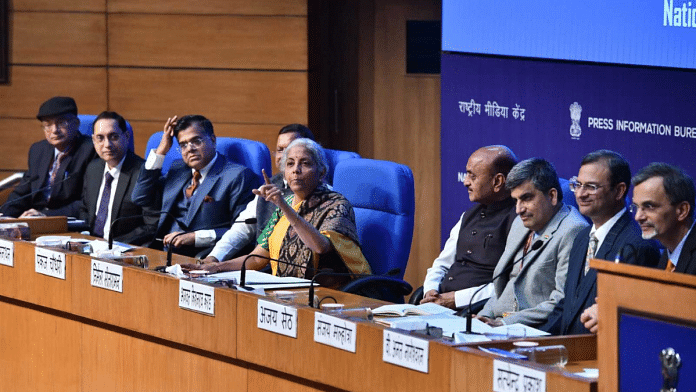When one looks at Budget 2023, two aspects need to be considered. First, the numbers. Because at the end of the day, these reflect the stance taken as well as throw light on fiscal management. Second is the language. Because there are a plethora of demands from various sections of the Budget. While most policies are announced outside the Budget, it becomes expedient to also touch upon virtually everything, so that all sections are placated. So how does Budget 2023 score here?
What story Budget numbers tell
On the fiscal math front, the Budget’s performance is very good. The fiscal deficit is to come down to 5.9 per cent, which means that the government is keen on reaching the target of 4.5 per cent by FY26. This will still be above an earlier target of 3 per cent, which seems like a mirage today. The commitment to reduce the gap reflects resolve and character. It may be remembered that during the Covid period, the deficit had increased sharply. Bringing it back to comfortable levels cannot be achieved at one stroke.
To lower the fiscal deficit, especially at a time when the nominal GDP is expected to grow at a slower rate of 10.5 per cent, several things have been done.
To begin with, the Budget has been conservative in the revenue collections projection through taxes as growth has been placed at the same rate as GDP. There can hence be an upside to collections.
The other measure involves seriously reviewing all the outlays that saw elevated levels due to the pandemic. Just like the RBI has spoken of withdrawal of accommodative stance, the Budget too is now walking in a similar direction. The subsidy bill has been brought down quite significantly. With global prices of fertilizers cooling down, the need to subsidise comes down. Further, food subsidy has been pruned with the disbanding of free food scheme and its merging with the PDS. This was a decision taken outside the Budget and hence is not new.
With these savings, the government has been in a position to enhance outlay for capex, which will now be around Rs 8.63 lakh crore (Rs 10 lakh crore if transfer of Rs 1.37 lakh crore to states are also included). Therefore, the Budget has been able to divert the savings on other schemes such as subsidies and NREGA for capital expenditure. This will be growth-enhancing for sure and has the potential to crowd in private investment (this is a hope because this has not materialised in the last few years). Further, the revenue deficit has also been targeted to be lowered to 2.9 per cent from 4.1 per cent in FY23 and in the absence of any external shock looks attainable.
Budgets are eventually a pure income and expenditure statement of the government. Therefore, the numbers are important. Because at the end of the day, they will affect the borrowing programme of the government as well as influence the debt level, which is what is tracked closely as it is still at 56 per cent of GDP. Though we are looking at bringing this ratio down to less than 50 per cent, it will be a tough task. As we move to 4.5 per cent fiscal deficit ratio, pressure on debt will continue.
Also read: FY24 Budget shows policy continuity amid fiscal uncertainty. But path ahead not easy
The language
It is here that the Budget excels. A budget speech is all about managing perceptions. Therefore, the part on individual taxation is significant. It needs to be seen as to how many people use the new tax scheme. But the impression given is that if one does away with the exemptions, they are better off. Similarly, the new savings benefits for senior citizens and women ring a strong bell but would actually mean moving money, if at all, from existing sources to the new schemes. With banks presently giving above 8 per cent for deposits of between 2-3 years maturity, there may not be much incentive to move over. But the impact is sharp as there is a feel-good factor created.
Similarly, the seven goals spoken of are aspirations of the government, which will mostly be pursued outside the Budget. The Credit guarantee scheme for MSMEs does not entail an outflow for the government and hence rings the right bell for these units. It is a contingency expense in case of a default. But there is a thumbs up here. Similarly, the target of Rs 20 lakh crore for farm credit strikes the right chord for agriculture even though it is a routine requirement for banks under the priority sector lending rule. There is talk of green energy, empowering youth and inclusive growth, which again strike the right note.
Hence the Budget has been well-crafted, giving the right signals while moving along in a determined manner on the path to fiscal prudence. The net borrowing programme of the government is almost at last year’s level, which is positive for the market as bond yields will remain stable. Contrary to expectations, there are no so-called populist schemes, and the cutback on the Covid-related outlays is quite bold in a pre-elections year. In fact, the government has also kept the excise collections target unchanged, which means that there will be no reduction in fuel prices this year. As inflation has started moving downwards, the Budget has kept silent on this score.
In short, the sanctity of budgeting has been preserved amid a lot of expectations, given that this is a pre-election year budget. This is probably the biggest takeaway from the budget.
Madan Sabnavis is Chief Economist, Bank of Baroda and author of Lockdown or Economic Destruction? Views are personal Views are personal.
(Edited by Anurag Chaubey)



